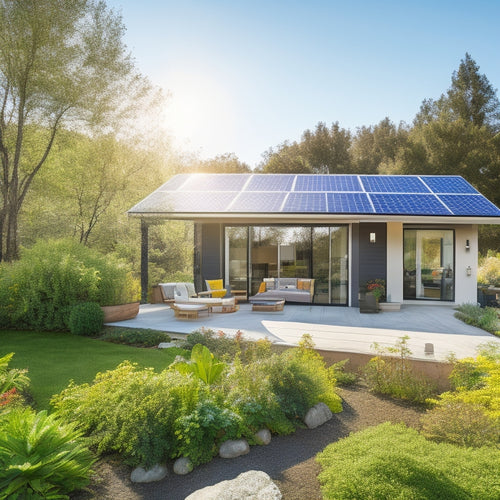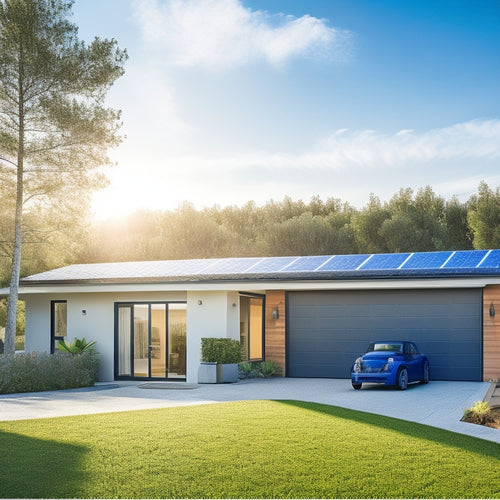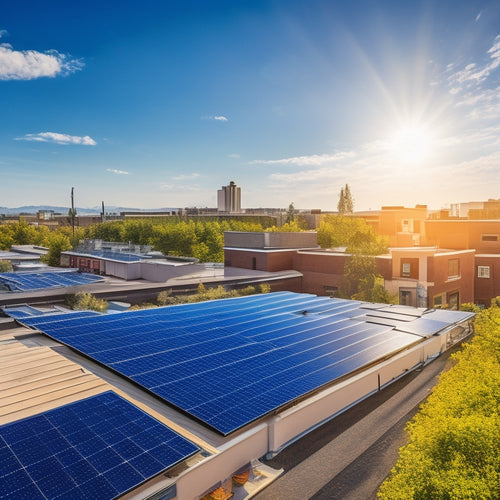
The Best Solar Panel Design for Maximum Energy Output
Share
When designing a solar panel system for maximum energy output, you need to evaluate multiple factors. You'll want to optimize panel angle and orientation, which varies by geographic location, and assess high-efficiency cell technologies like bifacial and tandem cells. Reducing shading and reflection through strategic positioning and anti-reflective coatings is also essential. Furthermore, innovative panel shapes and sizes, such as circular or hexagonal designs, can enhance energy collection. By combining these elements, you'll be able to access your system's full potential. Now, uncover how to strike the perfect balance and maximize your energy output.
Key Takeaways
- Optimal panel angle and orientation vary by geographic location, with southern orientation preferred in the northern hemisphere and more horizontal angles near the equator.
- High-efficiency cell technology, such as bifacial and tandem cells, can increase energy output by up to 25% and achieve efficiencies over 30%.
- Reducing shading and reflection through strategic panel positioning, anti-reflective coatings, and textured surfaces maximizes energy absorption.
- Innovative panel shapes and sizes, like circular or hexagonal designs, enable flexible configurations and easier maintenance for maximum energy output.
- Installation quality, including secure fastening and properly sized wiring, minimizes energy losses and ensures optimal solar panel performance.
Solar Panel Efficiency Factors
Since solar panels convert sunlight into electrical energy, their efficiency largely depends on several vital factors. As you consider the best solar panel design for maximum energy output, it's important to understand how these factors impact performance.
Temperature effects, for instance, can greatly influence efficiency. High temperatures can reduce panel efficiency by up to 0.5% per degree Celsius above 25°C. This means that panels installed in hot climates or with inadequate cooling systems will produce less energy than those in cooler environments.
Installation quality is another key factor. Poorly installed panels can lead to energy losses due to incorrect panel alignment, loose connections, or inadequate wiring. A well-designed installation will guarantee that panels are securely fastened, connections are secure, and wiring is properly sized to minimize energy losses.
Optimal Panel Angle and Orientation
When it comes to maximizing energy output, the angle and orientation of your solar panels are just as important as the installation quality and temperature effects you've considered so far.
To get the most out of your solar panel system, you need to enhance the angle and orientation to capture the maximum amount of sunlight throughout the year.
In terms of geographic considerations, the ideal angle and orientation vary depending on your location's latitude. For instance, if you're in the northern hemisphere, a south-facing orientation with an angle between 30-40 degrees is usually best.
However, if you're near the equator, a more horizontal angle is better suited to maximize energy output.
To further enhance energy output, consider making seasonal adjustments to your panel angle. During the winter months, a steeper angle can help capture more sunlight, while a shallower angle is better suited for the summer months.
High-Efficiency Cell Technology
Your solar panel system's energy output also depends on the type of photovoltaic cells used. High-efficiency cell technology plays an essential role in maximizing energy production.
You can opt for bifacial panels, which can increase energy output by up to 25% by utilizing energy from both the front and back sides of the panel. This design takes advantage of reflected light from the ground or surrounding environment, generating more power per unit area.
Another option is tandem cells, which stack two or more cells with different bandgaps to capture a wider range of sunlight. This design enables the cells to convert more of the sun's energy into electricity, resulting in higher efficiencies.
Tandem cells can achieve efficiencies of over 30%, markedly higher than traditional single-junction cells. By incorporating high-efficiency cell technology into your solar panel system, you can greatly enhance your energy output and reduce your carbon footprint.
With the right cell technology, you can generate more power and enjoy a faster return on your investment.
Reducing Shading and Reflection
By maximizing energy production through high-efficiency cell technology, you've taken a considerable step towards optimizing your solar panel system. However, even with the best cells, shading and reflection can greatly reduce energy output.
It's crucial to conduct a thorough shading analysis to identify potential obstructions, such as trees, buildings, or other obstacles that may cast shadows on your panels. This analysis will help you strategically position your panels to minimize shading and maximize energy production.
In addition to shading, reflection can also reduce energy output. To combat this, consider implementing reflection reduction strategies, such as using anti-reflective coatings or textured surfaces on your panels.
These techniques can help reduce the amount of sunlight that's reflected away from your panels, allowing more energy to be absorbed and converted. By minimizing shading and reflection, you can further optimize your solar panel system, ensuring you're generating the maximum amount of energy possible.
Innovative Panel Shapes and Sizes
Beyond traditional rectangular shapes, innovative panel designs are emerging to optimize energy output. You're now witnessing a shift towards unique geometric designs that deviate from conventional norms. These novel shapes are engineered to maximize energy collection by minimizing losses and utilizing more sunlight.
For instance, circular or hexagonal panels can reduce shading and reflection, allowing for more efficient energy conversion.
Modular panel systems are another area of innovation. By breaking down large panels into smaller, interconnected units, you can create a more flexible and adaptable system. This design enables you to optimize energy output by adjusting the angle and orientation of individual modules to suit specific environmental conditions.
Furthermore, modular systems facilitate easier maintenance and replacement of individual components, reducing downtime and increasing overall efficiency.
As you investigate these state-of-the-art designs, you'll realize that innovative panel shapes and sizes are no longer just a novelty – they're a necessity for achieving maximum energy output. By embracing these advancements, you can access the full potential of your solar panel system and reap the rewards of increased power generation.
Frequently Asked Questions
How Do I Ensure My Solar Panel System Is Compatible With My Roofing Material?
You confirm roofing compatibility by evaluating your roof's age, material, and condition, then selecting a solar panel system with compatible mounting hardware, considering installation factors like weight, drainage, and structural integrity to assure a secure and efficient setup.
Can I Install Solar Panels on a Metal or Asphalt Shingle Roof?
You'll be surprised to know that 70% of US homes have asphalt shingle roofs, perfect for solar panels! Yes, you can install solar panels on both metal roofs and asphalt shingles, but guarantee a compatible mounting system and roof penetration flashing for a secure fit.
Are There Any Local Building Codes or Permits Required for Solar Installations?
You'll need to research local regulations and obtain necessary permits before installing solar panels. You'll submit a permit application, including system design and installation plans, to guarantee compliance with local building codes and electrical standards.
How Often Should I Clean My Solar Panels to Maintain Optimal Performance?
You should clean your solar panels every 6-12 months, depending on local environmental factors, to maintain peak performance; regular panel maintenance guarantees maximum energy output, and adjusting cleaning frequency based on debris accumulation will enhance your system's efficiency.
Can I Expand My Existing Solar Panel System in the Future if Needed?
Like building on a strong foundation, you can expand your existing solar panel system in the future if needed, ensuring seamless system integration and future capacity, allowing you to utilize more power as your energy demands grow.
Conclusion
As you initiate the utilization of the sun's energy, remember that enhancing your solar panel design is essential to maximizing output. Like Archimedes' legendary mirrors focusing the sun's rays to ignite ships, your carefully crafted panel design can concentrate the sun's power to fuel your needs. By combining ideal angle and orientation, high-efficiency cell technology, reduced shading and reflection, and innovative shapes and sizes, you'll be well on your way to revealing the full potential of solar energy, and reaping the rewards of a brighter, more sustainable future.
Related Posts
-

Green Home Improvements Using Solar Power
Investing in solar power alters your home into a sustainable haven while slashing energy costs. You can greatly reduc...
-

Solar Energy Storage Options for Homes
When considering solar energy storage options for your home, you'll find several effective solutions. Battery systems...
-

Solar Energy Solutions for Small Businesses
Switching to solar energy can be a game changer for your small business. You'll enjoy significant cost savings on mon...


